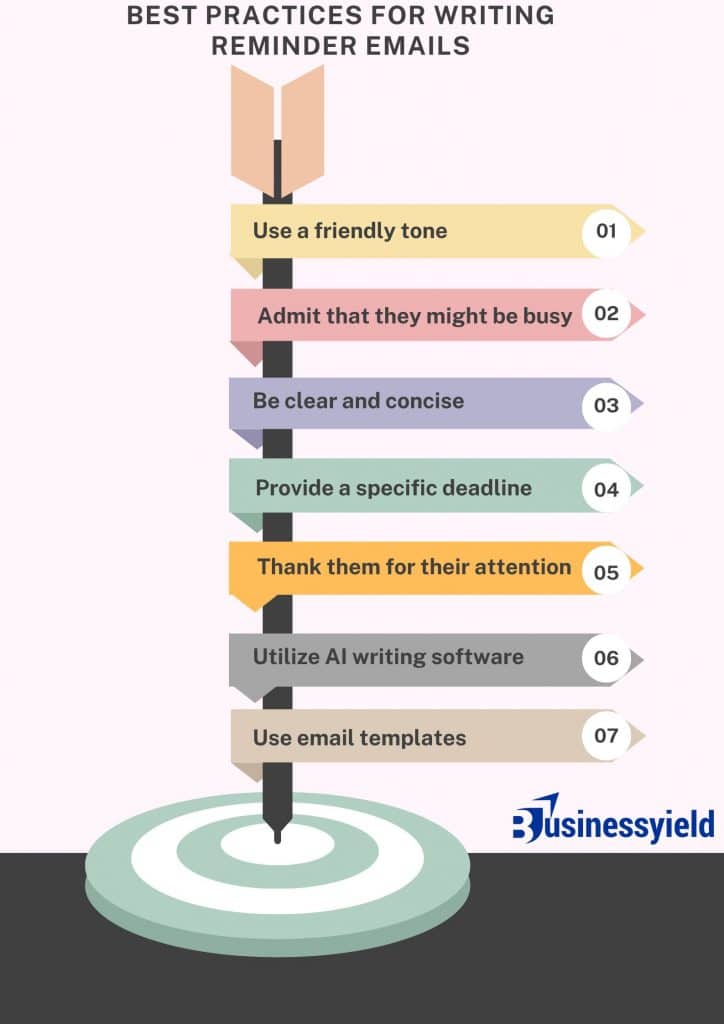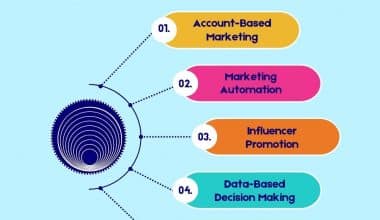Have you ever been in a situation where you needed to remind someone about something important, but didn’t want to sound pushy or impatient? Of course, you have. Figuring out how and when to send a friendly reminder email is a social dilemma that most people know all too well. The balance between the need to get things done and the need to respect someone else’s autonomy can be very tricky to find.
Over 319 billion emails are sent daily, while the average open rate is 16.97% across all industries. That means that billions of emails get overlooked in inboxes everywhere. So what can you do to get your message opened without being pushy or spammy?
The etiquette dilemma is easily solved with a well-written reminder. These are messages that get the point across without creating hard feelings. They’re professional and effective, yet friendly and gentle.
Knowing how to write a friendly reminder email is one of the best tools for nudging people about upcoming meetings, missed payments, job applications, important events, and more. And when done right, a good one can be a relief to recipients if you land the right tone and timing.
Key Takeaways
- Friendly reminder emails are a great way to engage your subscribers and nudge them to act. When planning to set up reminder emails, always remember the following tips and best practices:
- Keep your reminder messages and emails short and crisp;
- Create scroll-stopping reminder email subject lines that grab instant attention;
- Always keep your audience’s perspective in mind when you write a reminder email;
- Never be pushy or threatening in your reminder emails
What is a reminder email?
Reminder emails are sent to remind someone of upcoming meetings, appointments, forgotten agendas, or to follow up on past conversations. They are of two types, generally:
- Emails that serve as a recap of the call or meeting that just took place with a follow-up on future action;
- Reminder messages are sent to catch up on something that has failed to happen. For example, a follow-up on a missed deadline or no response after the initial email/call.
In this article, I will show you how to craft emails like this, along with examples and templates. But first, let’s learn when it’s appropriate to send a friendly reminder email, and how to find your perfect timing.

When should you send a reminder email?
Reminder emails are useful when something important is coming up or when something should have happened but didn’t. Here are some situations that could benefit from sending a reminder:
- Missed work deadlines. No worker is an island in today’s business world. If one person promises to complete a task by a particular day and it doesn’t happen, entire projects fall behind. It’s better to send an email reminder before too much time passes.
- Upcoming important events. Some events and deadlines are too important to risk missing. For these, you can send a gentle reminder in advance so everyone stays on track.
- Lapsed communication. Most people have been in a situation where someone promised to do something and get back in touch, but that message just doesn’t come. A reminder can help to re-establish contact and find out if the task just slipped the person’s mind or if there’s something else you can do to help.
- Late payments. Payment on or before a deadline is standard business etiquette. Things happen but you still have the right to your money. Don’t feel guilty about sending a payment reminder if a deadline has passed and you haven’t received those funds.
- Pending job applications or interviews. If you’re in the running for a job, a follow-up email can improve your chances of success. It’s important not to inundate the hiring manager with messages, but a carefully timed message can help you stand out.
- Vendor issues. Sometimes you’re the one who needs to pay, but a vendor hasn’t sent you an invoice. Alternatively, maybe you ordered something and it hasn’t arrived. Your business depends on that product or invoice, so it’s fine to get in touch and check in.
How to send a friendly reminder email
All friendly reminder emails should be clear, kind, and concise. You want to be polite enough to encourage people to take action but not so passive that people ignore your message.
The best email reminders have five core elements.
1. Subject line
A good subject line will get you far when sending reminder emails. The recipient should know why you’re sending a reminder and feel compelled to act. The main idea is to keep your subject line brief and add urgency so the recipient knows it’s time-sensitive.
2. Greeting
A greeting sets the tone for the body of your email, so don’t skip over it.
- Casual Greeting: Use a more informal greeting like “Hi there, Danielle” or “Hey, Jonathan.”
- Formal Greeting: If your company uses more formal language, start with “Hello, Kate.”
- Special Exception Greeting: Beginning with “Dear” is generally too formal for a friendly email reminder, but stick with it if that’s your company’s default greeting.
3. Context
The body of your email is where you let the recipient know why you’re emailing them. Here’s where you provide context about the project, deadline, payment, meeting, or whatever situation needs a nudge. Include specific names and dates if it helps clarify your message, and mention a recent tidbit about the person or company.
Here are a few examples of what this section can look like:
- With the end of the month (and the quarter) fast approaching, we’d like to get all invoices in as soon as possible.
- I’m still working on the article, Top Entrepreneurship Tips for New Founders, and would love to include your thoughts in the piece. With ABC company’s recent funding round and growth, you’ve navigated the past year so well.
- I’m checking in to remind you about the upcoming Q4 Content Planning meeting scheduled for this Tuesday, June 2 at 2 p.m. EST. Looking forward to starting it off with your analytics report.
- As you prepare for the presentation, please remember to send the slides you’d like to include by the end of the day on Monday, July 30. Does this still work for you?
4. Request
Once you’ve set the stage by providing context, it’s time to slide in your reminder or request. Don’t get too long-winded here or you may lose the recipient’s attention. If you want an immediate response, it’s helpful to wrap your request with a question to encourage people to take action right away.
- Please send your invoice for all work from our most recent contract to [email protected] and CC me. If you have any questions, you can reach me at (333) 333-3333.
- If you’d like to send in a quote for the article, please share your answer to the following question and explain your reasoning behind it. What tip would you give new entrepreneurs to help them successfully run their businesses this year?
5. Sign-off
You’ve made your main point and request, so it’s time to sign off with a friendly closing.
- Thank you for taking the time to work through this.
- Thank you for prioritizing this project.
- I appreciate your effort as we finish this proposal.
- I look forward to hearing from you.
Remember to include a closing sign-off that follows the same tone as the rest of your email.
- All the best
- Sincerely
- Thanks again
- Regards
- Thanks
Wrap up the email with your first name for a friendly tone, or your full name for a more formal tone. If you need to provide additional context, include your job title, company name, or contact information after your name.
Attached below is a template containing several friendly reminder email examples. You can use them to follow up with anyone for sales, networking, recruiting, or any other situation.
Friendly Reminder Email Templates
How long should you wait before sending a reminder email?
- Upcoming deadline. Varies by project. Give people more time for a complex project and a shorter time frame for a simple task.
- Upcoming event. Three to 14 days before the event. You can send multiple reminders leading up to the event to build enthusiasm and ensure everyone is clear about the timing and scheduling.
- Upcoming meeting. One to two days ahead of time. Give people involved in the meeting a few days of lead time, as they may have items to prep beforehand.
- Past due payment or deadline. One day after the due date. You want to remind people when it’s top of mind and show that you’re waiting for them to take action.
- Job application. The Muse recommends waiting five to 10 business days before following up. If someone recommended you for the position, check in with them for insight before contacting the HR team or hiring manager. This may seem like a long time, but Indeed found that 44% hear from employers within a couple of weeks of applying, and only 37% hear back within one week.
- Job interview. If an interview is scheduled a few weeks out, it’s best to check in the day before to ensure the time still works for everyone involved. If someone is supposed to contact you after a job interview, hiring managers suggest waiting until after the agreed-upon timeline to send a reminder email. Still no word? Wait five to seven days before hitting “send.”
Tips & tricks for creating friendly reminder emails
Writing a good reminder email is about continuously promoting the correct message rather than just reminding your recipient about your existence. Your emails must provide value and context, prove and give further evidence on your product/service, and explain why it would be beneficial.
Here are some general tips and tricks you need to know to go further in your follow-up email game:
- Don’t sound apologetic. Ensure your email doesn’t contain passive verbiage like ‘I hope this is a good time’ or ‘Just checking to see if you had a chance to look at my previous email.’ When sending a reminder email, ensure you have a valuable message to share;
- Clear call-to-action. Let your recipient know what you want them to do. Whatever your goal is, it must be clearly defined so the person knows the next step. If you are looking to schedule an appointment, it is advantageous to provide a link where it could be scheduled – an automated meeting confirmation email can follow once the booking is successful;
- Be polite. There can be a few reasons people don’t reply to you. They might be too busy, forget about it, or miss it the first time. It could also be that they are not interested and ghosted you. No matter why, you still have to approach your recipients with a polite and helpful tone, trying to understand the reasons for no response. It might take time, so be patient.
Friendly reminder email examples
General reminder email example
| To: Your Recipient From: You Subject: Follow-Up on My Timeline Request |
| Hi Stanley, Hope you’re having a good day! I wanted to quickly follow up on the timeline for this quarter’s projections. Last we spoke, I believe you said you’d have the action plan for the next few months by the end of the week. With that said, would you be able to send that over so I can share it with my team? Let me know if you have any questions for me here. Thank you, Jimmy |
Networking reminder email example
| To: Your Recipient From: You Subject: Coffee while I’m in town? |
| Hi Stanley, While I’m here in LA, I’d love to continue the conversation we had at the conference last weekend! I know you must be busy, but I’ve enjoyed our talks and would love to meet up once more. If you’re around, I’m flexible enough to work with your schedule while I’m in town. What days and times might work for you this week? Jimmy |
| To: Your Recipient From: You Subject: Thanks for Connecting on LinkedIn! |
| Hey Stanley, It was great to connect with you on LinkedIn last week. I’m touching base again with a few resources that I think would be helpful as your business tries to grow its marketing program. Marketing Plan Template: Use this to outline your marketing strategy this year. Digital Marketing Ebook: An Introductory Guide for Small Businesses. Advertising Planning Kit: Templates and a Guide for Smarter Advertising If this isn’t a good time for us to connect, I’d love for us to stay in contact. Submit this form so you can be the first to learn about our marketing and product updates straight from me. I’ll be looking out for your submission. Thanks! Jimmy |
Friendly reminder emails: Best practices
Here is a list of best practices to follow when writing a friendly reminder email:
Choose a clear subject line
An email subject line that clarifies your message’s purpose will increase the chances of people opening your email. If you’re reminding a customer about an event, for example, you might want to include the event name in your subject line.
Furthermore, you can incorporate powerful words and phrases like “important” or “response needed” to catch the reader’s attention and stand out in a crowded inbox.
Be brief
Brevity is something to practice throughout all your email marketing campaigns, but especially when writing reminders. Few people will read your reminder if you bury it in a wall of text.
Your contact won’t care how important the information is if it takes more than a couple of minutes of their time to read through it, so get to the point fast.
Be friendly yet direct
As you’re implying that your customer may have forgotten to do something, it’s important to tread lightly and adopt a friendly tone. Otherwise, you risk offending or irritating them.
However, you don’t want to go overboard and appear disingenuous. When writing, remember that this is a business-buyer relationship, and your aim isn’t to become the reader’s friend.
Find the right sending time
Timing might be the most important element of email success. The time you wait to send a gentle reminder email will depend largely on the situation.
For example, a day after the due date is usually acceptable when sending payment reminder emails. Waiting too long before sending your reminder can also hinder your chances of getting a response. The more time passes, the less your customers will remember they had something to complete.
A great solution to finding the perfect timing is to A/B test the delivery date and time. This is when you send two versions of a reminder to different audience segments, varying one element at a time, then analyze performance metrics, such as open rate, to see which version resonates better.
The perfect time to send an effective email will vary case by case, such as at the beginning or very end of the business day.
Include a call to action
Even though your main purpose is to remind people of something, there’s always room for additional feedback or engagement.
Adding a CTA button within your email or when you sign off will help the reader get to the bottom of the issue easily.
Follow up more than once if necessary
It doesn’t matter if your reminder is about a missing payment or a product launch, don’t be afraid to follow up if you feel your message is important, helpful, and worth reading.
Combined with good timing, a second follow-up email might get your customers to take action and complete the task at hand, even if that’s telling you they are no longer interested in purchasing or can no longer make an event.
Use it as a marketing opportunity
When possible and in context, add images or links of featured products. You can also promote upcoming offers or give an incentive to join your social media channels.
Remember when adding images to ensure they’re the correct size for all email service providers, such as Gmail, Outlook, and iCloud. A poor viewing experience may turn readers away from your brand and to a competitor’s.






